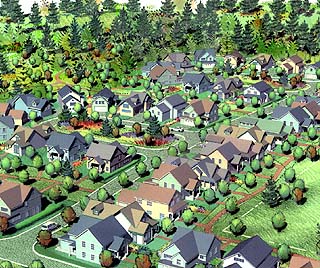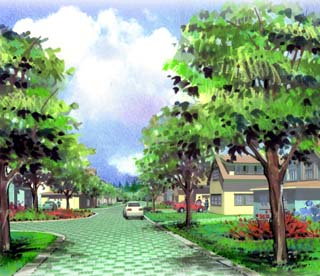
Surveys
DJC.COM
July 25, 2002
Managing stormwater in Pierce County
AHBL

Images courtesy of AHBL Low impact development techniques include retaining forests, clustering houses and adding open space and rain gardens. |
Pierce County over the last few years has been evaluating several regulatory options in response to the challenges the region faces with the federal listing of endangered salmon species.
Beyond these listings, which has forced communities throughout the region to evaluate maintenance and development practices, Pierce County is taking a comprehensive look at how stormwater is managed, both in terms of volumes and quality.
One thing is certain; regionally we need to do a better job of managing our stormwater closer at its source. Pierce County is looking to the application of low impact development (LID) techniques as a viable option in these efforts.
To better understand the potentials of LID, Pierce County recently completed a case study designed to evaluate the benefits for the application of the range of LID technologies. The results of the study reveal exciting opportunities for better managing stormwater, reducing development costs, and creating more livable communities.
LID is a land use development strategy emphasizing the maintenance and restoration of natural, pre-developed watershed hydrological functions. The goal of LID is to generate no measurable impacts to aquatic environments by maintaining and/or restoring the pre-developed stormwater flow volumes, rates, frequencies, durations and quality.
Natural, pre-developed watersheds achieve a balance between overland stormwater flows, infiltration, storage and evapotranspiration. LID strategies apply site and building development techniques designed to maintain this natural balance.
The LID design process assesses existing site soils, native vegetative cover, sensitive areas and drainage characteristics of both the site and surrounding watershed. Consistent with the overreaching goal of LID, the design process focuses on protecting, maintaining and/or restoring these natural site features.
Kensington Estates
The case study focused on the application of LID technologies to Kensington Estates, a conventional 103-lot single-family development planned on 24 acres in unincorporated Pierce County. The site was characterized by poor Class C and D soils, typical of those throughout south Pierce County. The goal of the study was to redesign the conventional project utilizing the new Western Washington Storm Hydrology Model (WWHM) and illustrate the full range of LID technologies in the redesign.
Several additional project objectives were important:
- Maintain the project density of 103 lots
- Design a roadway system adequate for emergency vehicles
- Achieve “zero” effective impervious surfaces
- Incorporate the full range of LID techniques, including soil rehabilitation, rain gardens, bio-retention, pervious pavement and pin foundation technology
- Provide adequate off street parking
- Reduce total project impervious pavement
- Minimize the use of piped conveyance
The redesigned LID project achieved all of the design objectives outlined, and resulted in a number of benefits that were not fully appreciated at the outset of the project. Utilizing the new WWHM, which storm drainage engineers will recognize is a continuous simulation model, rather than the current Pierce County “single” event model, the conventional project design required about 270,000 cubic feet (2 acres at a depth of 3 feet) of stormwater storage on site. The LID design reduced the storm pond storage requirement to less than 55,000 cubic feet (about .5-acre at a depth of 3 feet) — a reduction of more than 75 percent.
A cost evaluation of the redesign further illustrated the potential benefits of LID. Overall, the LID project resulted in construction cost savings of over 20 percent versus the conventional project. The majority of savings was achieved through the reduced size of the storm pond structures and the elimination of catchments and piped storm conveyance. Excavation and erosion control costs were also significantly reduced.
Costs associated with roadway and utility construction were roughly the same or slightly higher due to the proposed use of porous paving and the “looped” cul-de-sac clusters designed for emergency vehicle access. This was the case even though a roadway width of 20 feet was proposed in the LID design.
Other benefits
Beyond the project cost savings and significantly reduced storm drainage infrastructure, the demonstration project incorporated many of the features characteristic of truly livable neighborhoods. The design included an internal walkway and open space system facilitating unimpeded pedestrian access throughout the project. Additionally, about 62 percent of the site was preserved as open space.
Site design, using zero-lot line side yards and flexible front and rear yard setbacks, allowed each home to be sited in response to lot orientation. The smaller LID lots (4,100 square feet compared to 7,200 in the conventional design) still maintained reasonably sized, private outdoor living space.

How a low impact development streetscape might look like. |
Home sizes allowed for living areas of between 1,600 and 1,800 square feet with living space designed over two-car garage areas. Each lot accommodated two off-street parking stalls for each home. Additional common parking areas were provided in cul-de-sac clusters.
The case study evaluation clearly demonstrated the potential cost benefits of LID site design. Significantly reduced site construction costs will be the most notable benefit to the development community. Cost savings can vary, however, in relation to the specific LID technologies required by a jurisdiction and the ability to maintain the net project densities.
One benefit of LID will be its potential to assist in maintaining residential densities.
The application of the new WWHM will result in larger, more expensive storm drainage facilities.
In the conventional Kensington Estates project, the resulting increase in area required for infrastructure would have resulted in a loss of up to 10 percent of the project unit count — a factor not considered in the cost evaluation.
More area required for storm ponds means less area available for housing. LID applications, coupled with clustered site planning on smaller lots, will provide an avenue for communities to maintain densities and housing affordability.
The most significant benefits of LID applications will be the positive environmental effects on urban watersheds. To encourage a site planning and design ethic that works toward maintaining the water balance achieved in nature will be the most significant contribution of LID projects.
Pierce County is currently working with a developer to design and build a 37-unit housing project which will incorporate a range of low-impact design features. The goal of the project, located along Pacific Highway near Fife, will be to demonstrate the application of sustainable site design components, while maintaining density and housing affordability. The project will be designed by AHBL in cooperation with Pierce County. Preliminary design approvals are expected by the end of the year, with final engineering approvals and construction expected during 2003.
Len Zickler, AICP, ASLA, is a principal of AHBL Inc. of Tacoma. A planner and landscape architect, Zickler consults with communities throughout the Pacific Northwest. For more information on the Pierce County demonstration project, contact Zickler at (253) 383-2422.
Other Stories:
- Water storage goes underground
- Getting back to basics with LEED
- Seattle LEEDs the nation in sustainable building
- New stormwater rules looming for contractors
- An incubator for cutting-edge power projects
- Linking up with the environment
- Designers find new life for old cardboard tubes
- EPA turns up the heat with temperature rules
- AGC teams with WSDOT for environment’s sake
- A wholistic look at engineering
- Toxic black mold — the next asbestos?
- Mold: Getting a grip on the fuzzy stuff
- A trail of mining waste turns into a trail of recreation
- No more fuming at chemistry class
- A battery of energy information
- New brownfields law comes with big changes
- ‘Green infrastructure’ puts Seattle on the map
- Detention ponds – all it takes is a little magic
- Ground zero for groundwater
- A pearl of a project on Oyster Creek
- BetterBricks program stacks up energy savings
- Shopping ‘green’
- Home Depot builds atop an old Oregon landfill
- Making clean water the green way
- Salmon in the city: Seattle restores fish habitat
- A funny thing happened on the way to the dump
- Reducing energy costs, post crisis
- Does best available science work for all buffers?
Copyright ©2009 Seattle Daily Journal and DJC.COM.
Comments? Questions? Contact us.